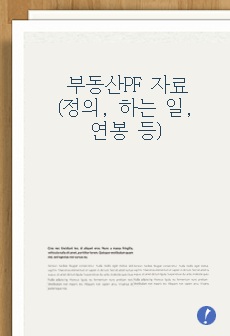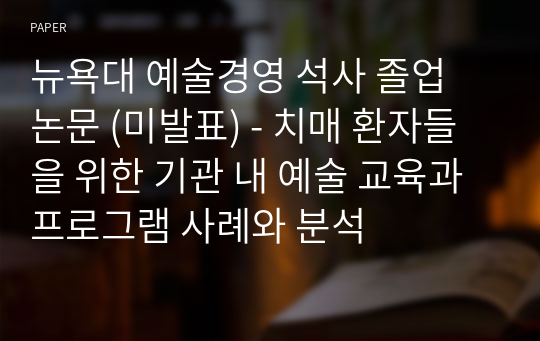뉴욕대 예술경영 석사 졸업 논문 (미발표) - 치매 환자들을 위한 기관 내 예술 교육과 프로그램 사례와 분석
eunjj0125
다운로드
장바구니
소개글
"뉴욕대 예술경영 석사 졸업 논문 (미발표) - 치매 환자들을 위한 기관 내 예술 교육과 프로그램 사례와 분석"에 대한 내용입니다.목차
I. IntroductionII. Literature Review
1. Dementia
2. Effectiveness of Creative Arts Therapy
3. Benefits of Performance programs and Arts-based therapy interventions
IV. Methodology
V. Results
VI. Recommendation
1. Creative arts therapists should participate in the programming process, staff training, and during the programs
2. Create a sustainable relationship with local the health-care industry
VII. Conclusion
본문내용
As the pace of population aging around the world increases dramatically, we are facing unprecedented public health challenges in many different fields. According to the World Health Organization (WHO), by 2050, the proportion of the world's population over 60 years will nearly double from 12% to 22% and 80% of all older people will live in low and middle-income countries. This progressive aging of society has led to dementia becoming one of the main age-dependent illnesses to affect public health (WHO, 2018).In the long run, researchers in the United Kingdom expect one in five people will get dementia in the future. For the two-thirds that live at home, their memory loss leads to anxiety, confusion, an increase in stress and isolation. These feelings are exacerbated by a perceived stigma that brings a sense of shame and low self-esteem. Indeed, Alzheimer’s Society figures show that 63% feel anxious or depressed, 39% are lonely..
<중 략>
참고 자료
Adams, J., & Brandt, S. (1997). Behavioral Implications of the Project Life Cycle. In D. Cleland, & W. R. King, Project Management Handbook, Second Edition. John Wiley & Sons, Inc.
Alexopoulos, G., Abrams, R., & Young, R. (2017). Cornell scale for depression in dementia. Biological Psychiatry, 23:271-284. All-Party Parliamentary Group on Arts, Health and Wellbeing Inquiry Report. Creative Health: The Arts for Health and Wellbeing.
American Psychiatric Association. (2000). Diagnostic and statistical manual of mental disorders. Fourth Edition, text revision. Washington, DC: American Psychiatric Association.
Arts 4 dementia. (2012). London Arts Challenge, 2012. Retrieved from Arts 4 dementia: https://arts4dementia.org.uk/london-arts-challenge-2012/
BWW News Desk. (2017, 3 16). Lincoln Center Moments, a Free Program for Individuals with Dementia and Their Caregivers, Set to Launch on 3/17. Retrieved from broadway WORLD: https://www.broadwayworld.com/article/Lincoln-Center-Moments-a-Free-Program-for-Individuals-with-Dementia-and-Their-Caregivers-Set-to-Launch-on-317-20170316
Clare, A., & Camic, P. M. (2019). Live and recorded group music interventions with active participation for people with dementias: a systematic review. Arts & Health.
Cleland, D., & Ireland, L. R. (2006). Project management : strategic design and implementation. New York: McGraw-Hill.
Clements-Cortés, A. (2015). Singing for Health, Connection and Care. Music and Medicine.
Clements-Cortés, A. (2017). Artful wellness: Attending chamber music concert reduces pain and increases mood and energy for older adults. The Arts in Psychotherapy .
Coaten, R., & Newman-Bluestein, D. (2013). Embodiment and dementia Dance movement psychotherpists respond. Dementia.
Falk, J. H., & Dierking, L. D. (2000). Learning from museums: Visitor experiences and the making of meaning. Lanham, MD: AltaMira. .
Gerdner, L. A., & Schoenfelder, D. P. (2010). Evidence-based guideline: Individualized music for elders with dementia. Journal of Gerontological Nursing,.
Ginsborg, J. (2015). Music and Memory. London, UK: Arts 4 Dementia.
Gould, V. F. (2013). Reawakening the Mind: Evaluation of Arts 4 Dementia’s London Arts Challenge in 2012: Arts interventions to re-energise and inspire people in the early stages of dementia and their carers. Arts 4 Dementia.
Gould, V. F. (2015). Music Reawakening: Musicianship and Access for Early to Mid Stage Dementia – The Way Forward. Arts 4 dementia.
Halpern, A., Ly, L., Elkin-Frankston, S., & O'Connor, M. (2008). I Know What I Like: Stavility of aesthetic preference in Alzheimer's paitents. Brain and Cognition.
Hannemann , B. T. (2006). Creativity with dementia patients. Can creativity and art stimulate dementia patients positively? Arts & Age.
Hulko, W. (2009). From 'not a big deal' to 'hellish': experiences of older people with dementia . Journal of Aging Studies.
Joanne Loewy, J. A. (2016). Music therapy in neurologic dysfunction to address self- expression, language, and communication: The impact of group singing on stroke survivors and caregivers. Plural Publishing.
Kaplan, F. F. (2007). Art therapy and social action. PA: Jessica Kingsley.
Karmakar, M. (2016). Potentials of creative and arts-based approaches and its impact on quality of life in the context of dementia care. Indian Journal of Health and Wellbeing.
Kemp, E., & Poole, S. M. (2016). Arts Audiences: Establishing a Gateway to Audience Development and Engagement. THE JOURNAL OF ARTS MANAGEMENT, LAW, AND SOCIETY.
Loewy, J., Ard, J., & Mizutani, N. (2015). Music therapy in neurologic dysfunction to address self- expression, language, and communication: The impact of group singing on stroke survivors and caregivers. I. ommunication and aging: Creative approaches to improving the quality of life .
Loewy, J., Torossian, A., Appelbaum, M., Fleming, A., & Tomaino, C. (2019). Lincoln center moments: integrating accessibility and enhancement through expanding performing arts experiences. Art & Health.
Mansfield, C. (2011). The impact of stimuli on affect in persons with dementia. Physicians Postgraduate Press, Inc.
Mittleman, M., & Epstein, C. (2009). Research: meet me_Making Art Accessible to People with Dementia. Museum of Modern Art.
Nyström, K., & Lauritzen, S. O. (2005). Expressive bodies: demented persons' communication in a dance therapy context. Health: An International Journal for the Social Study of Health, Illness and Medicine.
Peacoak, H. K., & Dumlao, K. (2014). Art therapy access programs. Memphis Brooks Museum of Art.
Rochford, J. S. (2017). Art Therapy and Art Museum Education: A Visitor-Focused Collaboration. Journal of the American Art Therapy Association.
Rosenberg, F., Parsa, A., Humble, L., & McGee, C. (2009). meet me: Making Art Accessible to People with Dementia. The Museum of Modern Art.
Särkämö T, T. M. (2014). Cognitive, emotional, and social benefits of regular musical activities in early dementia: randomized controlled study. Gerontologist.
Simon, N. (2010). The participatory museum. . CA: Museum 2.0.
Sliverman, L. H. (2010). The social work of museums. . Routledge.
Smith, N., Waller, D., Colvin, A., Naylor, M., & Hayes, J. (2012). Dance and Dementia Project: Findings from the pilot study . University of Brighton.
Stige, B. (2006). The Problem of Pleasure in Music Therapy. British Journal of Music Therapy.
Sutherland, M., Ward, R., & Rivers, I. (2012). Lesbian, Gay, Bisexual and Transgender Ageing : Biographical Approaches for Inclusive Care and Support. Jessica Kingsley Publishers.
Takahashi, T., & Matsuchita, H. (2006). Long-Term Effects of Music Therapy on Elderly with Moderate/Severe Dementia. Journal of Music Therapy.
Turabian, K. L. (1937). A Manual for Writers of Research Papers, Theses, and Dissertations, 9th edition. Chicago and London: The University of Chicago Presss.
Victoria, T., Justine, S., Christian, M., Paul, C., Tom, D., DAWN, B., . . . De. (2019). Stronger together: learning from an interdisciplinary dementia, arts and well-being network (DA&WN). Taylor & Francis.
Weil, S. E. (2002). Making museums matter. Smithsonian Institution.
WHO. (2018, 2 5). World Health Organization (WHO). Retrieved from Ageing and health: https://www.who.int/news-room/fact-sheets/detail/ageing-and-health
WHO. (2020, 04 19). Statement of the Republic of Korea. Retrieved from World Health Organization (WHO): https://www.who.int/mental_health/neurology/dementia/Member_State_Republic_of_Korea.pdf?ua=1
Wood, S. (2007). Chalfond lodge choir: Heart of a home and community. Journal of Dementia Care.

























